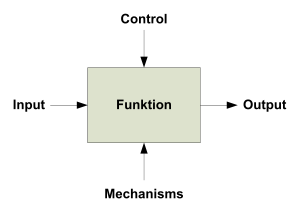- Structured Analysis and Design Technique
-
Die Structured Analysis and Design Technique (SADT) ist eine Methode zur Softwareentwicklung, die 1977 von Douglas T. Ross publiziert wurde[1]. Ein Abkömmling davon ist IDEF.
Basiselement der Modellierung ist die Funktion, dargestellt als Rechteck, die Eingangsgrößen (engl. Input, Pfeile von links) in die Ausgangsgrößen (engl. Output, Pfeile nach rechts) transformiert. Für die Ausführung werden Mechanismen (engl. Mechanisms, Pfeile von unten) benötigt, zum Beispiel Ressourcen. Weitere Einflüsse oder Störgrößen (Control) werden als Pfeile von oben dargestellt.
Mehrere Funktionen können hintereinander ausgeführt werden, in der eine Ausgangsgröße der einen Funktion mit der Eingangsgröße der anderen verbunden wird.
Die schrittweise Modellierung kann top-down erfolgen. Eine Funktion wird hierbei hierarchisch zerlegt, d.h. eine Funktion einer Ebene, wird in der nächsten Ebene als Verschaltung mehrerer Teilfunktion dargestellt.
Einzelnachweise
- ↑ D. T. Ross: Structured Analysis (SA): A Language for Communicating Ideas. IEEE Transactions on Software Engineering, SE-3(1), pp. 16-34. Abstract
Weblinks
- IDEF 0 – Overview
- Draft Federal Information - Processing Standards Publication 18, 21. Dezember 1993 (.doc, 677 kB)
Wikimedia Foundation.

